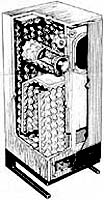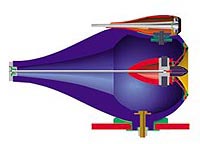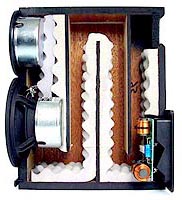 |
|||||||||||||||||||||
| A recent Internet thread began with the query "What defines a transmission line?" Though it might seem obvious at first -- most of us have certain notions about what constitutes a loudspeaker transmission line -- upon further inspection, this question is far more trying than apparent. Regardless of whom you ask, everyone agrees on the theoretical ideal of a TL (the short-form moniker for a transmission line): A virtual black hole behind a driver absorbing all its rear-firing out-of-phase energy. Pioneering inventors like Olney (1930) and Stromberg-Carlson (1950) accomplished this with huge and very large sealed labyrinths behind their drivers. As Martin J. King shows on his website QuarterWave.com, a full-length line for a driver with an F1 (resonant frequency) of 29.3Hz would have to be 11.7 meters [hover mouse for photo credits]. |
|||||||||||||||||||||
 |
By 1965, Bailey designed a line with a terminus and used fibrous stuffing rather than the absorptive lining of his predecessors. This signaled the launch of more practical TLs which now became shorter to fit into smaller cabinets. The stuffing inside increased air density, slowed sound propagation and made the line behave longer than it physically was. However, the appearance of a terminus compromised the former ideal of the perfect non-resonant transmission line. While nearly all current amateur and commercial TL designs employ variations on Bailey's theme -- a heavily damped, often folded and tapered line, pipe or tunnel that absorbs most of the energy input of its driver and vents the remainder, heavily attenuated, through what is called a terminus to distinguish it from the port of a vented alignment box -- none of them could be called a true TL if held rigorously to the original definition - that of a sealed line that attenuates all incoming energy to completely zero like a black hole. |
||||||||||||||||||||
| Therein lies the crux of fixing what defines a true transmission line. The presence of a terminus introduces a cabinet resonance which, just like a vented alignment, shows up as the lower impedance peak of the famous "saddle" of twin spikes, one for the driver, one for the port. By exhausting much of the input energy through absorption (via a combination of damping and captive internal reflections), the severity of these electrical impedance peaks is minimized. However, heavy stuffing of a vented alignment too can suppress this resonant ringing to measure as shallower impedance peaks. If such a heavily damped vented box acted like a TL in that particular regard, does it constitute a proper transmission line? |
|||||||||||||||||||||
 |
Looking at companies who produce commercial designs dubbed TLs, we find Bud Fried's IMF and now-defunct TDL offspring; B&W in its showcase Nautilus and continued use of tapered-tube tweeter loading; Morel's Renaissance Prelude; Shahinian's Hawk and Double Eagle subwoofers; Chapman Sound Company; Buggtussel; Professional Monitor Company aka PMC; InnerSound with its hybrid woofer loading; Meadowlark Audio; RA Audio. All of these companies incorporate some form of physical line as indicated by the raw term transmission line. Subwoofer specialist VBT recently acquired a patent for its hybrid invention. It combines a radial TL with a port in what is considered a unique form of woofer loading. It severely minimizes excursion demands on the driver, by adding requisite acoustical gain via the cabinet loading. |
 |
|||||||||||||||||||
| A Von Schweikert Audio VR-2 customer's recent removal of a woofer, to inspect what the product propaganda referred to as a triple-chambered transmission line, and his subsequent Internet post and resultant threads all pointed at our collective confusion over how to answer today's opening question: What defines a transmission line, exactly? The VR-2's designer defines it as a non-resonant enclosure with highly damped impedance peaks. He claims fulfillment of this definition by creating two internal chambers with a suspended stuffing blanket. It separates a highly stuffed upper portion from a lesser stuffed lower portion which, in conjunction, are said to operate as a third chamber venting into the room via a port. By affixing the term 'hybrid' to said loading scheme, Von Schweikert distinguishes his approach from the kind of discretely partitioned labyrinths other TL designers achieve with extensive internal cross-bracing. |
|||||||||||||||||||||
 |
Truth be told, nearly all present-day TLs are hybrids. They all depart from the original requirement, of complete & sealed absorption of a driver's rear wave. Exceptions? Perhaps the Nautilus tweeter loading tunnels employed by B&W. Because of the shorter HF wavelengths involved, complete attenuation would be far easier achieved than with woofers, though I'm not sure whether B&W claims complete absorption. They clearly don't refer to this solution as a transmission line but rather, a tapered pipe. Many TLs are tapered pipes, true - but most of them involve folds or bends which B&W's design does not. Why the insistence on capturing a driver's retrograde emissions? Because they're out-of-phase with in-room radiation to cause cancellation. Since all driver diaphragms are acoustically transmissable, reflected rear energy can pass through them, delayed in time and rotated in phase, to interact with the front-firing signal and cause intermodulation and distortion. Removing all or most of this distortion naturally benefits resolution, timbral purity and precision. |
 |
|||||||||||||||||||
| Two approaches to absorb or minimize this rear-firing driver output are: Stuffing/damping with fiberglass thermal blankets, polyester fiber, microfiber, nylon polyamide fiber sold under the 'Acousta-Stuff' brand, cotton puffs, steel wool, packing pellets, and plastic foam; and labyrinth/line exhaustion similar to how dams, piers and pilings in a harbor break up and attenuate ocean waves. The latter approach tends to be used in conjunction with the former, by either lining the TL's walls partially or completely with felt/foam or stuffing the line. As Peter Thomas of PMC explained, TL designers must consider the following variables: Length of line; cross-sectional shape; cross-sectional area; number of folds; type of acoustic absorption material; quantity of material; density of material; placement of material; Thiele/Small driver parameters expressed as Vas/fs/Qt, or, respectively, the volume of air having the same acoustic compliance as the driver suspension; resonance frequency of the driver; its ratio of reactance to resistance (series) or resistance to reactance (parallel). Little mathematical equations exist in textbook speaker design to help a TL designer determine these parameters without extensive prototyping and testing. Kevin Blair of Buggtussel and the aforementioned Martin J. King have developed proprietary or publicly accessible test data and predictive formulae, to explain certain aspects of TL performance and assist a designer in optimizing it. As it true for all design philosophies, execution becomes paramount to ultimate performance. A TL per se can sound worse than a bass reflex design or vice versa - the magic's in the details. |
|||||||||||||||||||||
| Most labyrinth-style TLs are 1/4, 1/2 or 3/4-wave lines, i.e. their length is proportional but not identical to the wavelength of the loaded driver's F1. In King's example, the 11.7 meter full-wave line becomes 2.9 meters in a quarter-wave arrangement. A variation on this theme is called Voigt Pipe or TQWP which stands for Tapered Quarter Wave Pipe. It's often used for full-range driver designs, places the driver not at the end of the line but 1/3 into it, and is described as a combination of Helmholtz resonator, transmission line, bass reflex and rear-horn loading. Due to line resonance comb filtering effects, stuffing is recommended, the judicious balance thereof affecting internal air speed, effective line length and speaker sensitivity. A commercial example of a TQWP is Cain & Cain's Abby. |
 |
||||||||||||||||||||
 |
|||||||||||||||||||||
| Besides minimized resonance behavior as measurably expressed in the reduction of the electrical impedance peaks (which Von Schweikert showed can be achieved by judiciously damping a non-labyrinth cabinet), are there other measurable parameters that would clearly distinguish TLs from vented or sealed alignments? Common sense predicts that the claimed rear-wave absorption efficiency of transmission lines should be measurable. Simply compare signal input strength at the driver against the output at the mouth of the line - the terminus. Peaks in the measured response would indicate internal line resonances (sometimes referred to as organ pipe resonances) while the overall attenuation rate should provide a means to compare the same driver in a box of identical air volume, but without the labyrinth. If the former measurement was considerably lower, the TL would have shown to live up to its claim of significantly attenuating rear wave radiation. How readily the claimed reduction in distortion could be measured (signal reflected inside the box re-appearing in front of the driver by leaking through its membrane) I can't say - but for a scientific comparison of the subject, it seems mandatory. According to PMC's Peter Thomas, another distinctive feature of proper TL loading is a slowing of LF roll-off, measured as -6 and -12dB down points and indicative of a shallower rate of attenuation that extends useful in-room bass response. At the end of the day, much of this is a function of terminology and associated expectations. The term 'transmission line', in many consumers' minds, has become synonymous with a serpentine path down which the rear wave has to travel before it vents into the room. In a very graphic way, this distinguishes the internal construction of a TL enclosure from a vented or sealed design that uses internal braces merely to stabilize large panels for flex reduction, but not to construct a clearly defined pathway. Is the performance between either comparable? This would be for test bench aficionados to determine, and, naturally, the consumer who's primarily interested in subjective listening impressions, not how the enclosure achieves them. |
|||||||||||||||||||||
| To avoid unintentionally misdirecting expectations as happened with the VR-2 customer who started the recent thread on Audio Asylum by looking for a TL like PMC's to the left, perhaps Von Schweikert's term 'hybrid TL' could be further defined to include the words 'non-labyrinth' ? Or perhaps makers of traditional line enclosures could adopt the term 'classic TL' like our own Mike Healey -- in his recent review of the Kestrel2 -- suggested in a clever bow to Coca-Cola? After all, motorcycle makers get very specific about how they describe their engines. Besides mentioning the number of cylinders, they also refer to in-line or angled configurations plus overall orientation. Customers thus can readily relate to the differences between horizontally-opposed twins (BMW), in-line V-twins (Harleys and most Japanese cruisers), transverse V-twins (Moto Guzzi) and all other layouts involving 3, 4 or 6 cylinders. | |||||||||||||||||||||
 |
|||||||||||||||||||||
 |
|||||||||||||||||||||
|
Naturally, every manufacturer believes his particular approach superior at addressing global design challenges. To differentiate his solutions from others, he must employ descriptive terminology. Confusion sets in when, as in the case of transmission lines, clear-cut definitions of used terms are hard to come by - or don't exist, period. As we've shown, practically every TL in the book today is already a hybrid though most simply refer to themselves as transmission lines. The use of vents, as shown in Buggtussel's flagship speaker [upper right], doesn't externally distinguish a TL from a conventionally ported design. The giveaway size of the box, the unusual weight from the excessive internal bracing, and the rectangular shape and large size of the vents seemingly common for TLs are indicators; but not proof unless you opened up the enclosure. What if you sliced it in half with a band saw and found no labyrinth? As Von Schweikert explained, a vented bass reflex box may afford certain behavioral aspects of traditional TL loading without being built like one. If it quacks like a duck but doesn't look like one - is it a duck or something else? An interesting question that involves semantics, expansions of conventions and reworked definitions. Incidentally, Kevin Blair of Buggtussel refers to his designs as q-TSAL (quasi-Thiele/Small Actuated Labyrinths) and explains on his website that his creations employ 1/4-wave theory and line proportions in conjunction with modern computer modeling. While not a particularly snazzy, easy-off-the-tongue term such as marketeers prefer, it's about as descriptive as one could ask for. It leaves no doubt what to expect when this particular manufacturer refers to his loudspeaker enclosures as TL designs. It doesn't speak to performance but simply describes according to which design philosophy his boxes are built, and which of the possible models of existing TLs (1/4-wave in this case) have been employed. Damn, this subject seems more complicated than a casual assumption would have predicted - and perusing King's extensive computer models and associated math only confirms that there's more than meets the eye when considering Teutonic Lobotomy: Terminus Longus, the venerable loudspeaker transmission line dubbed TL. |
|||||||||||||||||||||
 |
|||||||||||||||||||||
 |
|||||||||||||||||||||